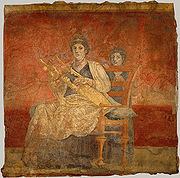
Roman bust of Antinoo. Exhibited at the Louvre Museum in Paris.
Roman art are all those manifestations of the visual arts that were exported to all the territories of the Roman Empire. The first manifestations arose under the influence of Etruscan art and were later influenced by Greek art, which the Romans met in the colonies of Magna Graecia, located in southern Italy and which they conquered in the process of territorial unification of the peninsula during the IV and III a. C. The Greek influence increases when, in the II century B.C. C., Rome occupies Macedonia and Greece.
To some extent it could be thought that the art of Rome is an imitation and expansion of Greek art, and of course one of the best Etruscan art, but the spirit that animated the artists of those. The conquering and urbanist Rome tried to unite the Greek aesthetic sense, the utilitarian and functional character that their works required.
From a chronological point of view, Roman art developed fairly homogeneously and autonomously from the III century B.C. C. up to the V century. Following the stages that its historical evolution marks, at least the Republic stands out, until the year 27 a. C., and the Empire, which lasted from the time of Augustus until the fall of Rome into the hands of the barbarians in the year 476.
Because of the deep centralism exercised by Rome over its provinces in all aspects of life, a very uniform art originated without the possibility of speaking of provincial schools, at least during the imperial era. However, given the breadth of the Empire and its constitution at different times, there is no chronological contemporaneity, since in the eastern areas where Hellenistic art is more consolidated, its artistic forms are much more evolved than in the western provinces that were later incorporated into the Empire. Roman culture.
Ancient Roman Painting
Main article: Painting of Ancient Rome
| View of a villa, trapntojo in a fresco by Boscoreale.
|
| Portrait in golden glass, centuryIV.
|
| Wedding of Céfiro and Cloris, fresh pompeyano.
|
| Wall painting in Pompeii.
|
| Villa de los Misterios, Pompeii.
|
|
Ancient Roman Sculpture
Main article: Sculpture of Ancient Rome
| The Good Shepherd, CenturyIII. |
|
Architecture of Ancient Rome
Main article: Architecture of the Ancient Rome
See also: Segobriga, Baelo Claudia, Volubilis and Sbeitla.
See also: Archaeological group of Mérida, Archaeological Set of Tarraco e Itálica.
See also: Costumes of Ancient Rome, Roman city and Roman Art in Hispania.
See also: Tréveris Black Gate, Muro de Adriano, Walls of Lugo and Roman camp.
Scheme of the arts in Ancient Rome
The Roman Monarchy, Roman Republic and Roman Empire cover the period from the 8th century B.C. C. al V d. C. It is located first in Lazio (Central Italy), and will end up spreading throughout the Mediterranean Basin (Mare Nostrum ).
In the period prior to the reception of Hellenistic culture (III century BC) an art developed Latin related to other Italic peoples (Sabines and especially Etruscans), for example, the Capitoline Wolf.
The classical period of Roman art lasts until the triumph of Christianity (IV century). It assimilates and develops Greek culture (architectural orders, temple design, sculptural conception), incorporating its own characteristics, both in construction materials (Roman mortar, cement and concrete) and in architectural elements (the arch -Triumphal Arch- and the vault, Tuscan order and composite order, principle of overlapping orders) and sculptural forms (the Roman portrait -required by the cult of ancestors and political propaganda, and which allows us to date the stylistic and fashion evolution, especially in the expression and hairstyle- and the Roman relief, characterized by the search for depth and perspective) and pictorial (Pompeian, decorative, narrative styles or seeking trompe l'oeil).
Architectural development with a taste for the colossal and magnificent, at the same time as with a strong practical and utilitarian sense. (bridges and aqueducts -Alcántara Bridge, Pont du Gard, Segovia Aqueduct-, roads).
Public buildings (baths -Baths of Caracalla-, Roman theater -Marcelo Theatre-, Roman circus -Circus Maximus-, amphitheaters -Amphitheater of Capua, Colosseum, Amphitheater of El Djem-, etc.), religious (Roman temple -Temple of Vesta, Maison Carrée, Agrippa's Pantheon-) and civil (Roman forum, basilicas, Roman palace -Domus Aurea de Nero, original construction of the Lateran Palace, later converted into a papal residence-, Roman villa -Villa romana del Casale- with its version of imperial villa -Villa Jovis or of Tiberio in Capri, Villa Adriana-, Roman house -domus, dwelling (Ancient Rome)-).
Narrative historical sculpture (frisos corridos en relief: Ara Pacis, Columna trajana), busts, statues of whole body (Augusto de Prima Porta) and exceptionally equestrians, reserved to the emperors (the equestrian statue of Marco Aurelio).
Más resultados...

















